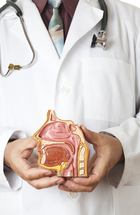Endoscopic Sinus Fracture Repair
 A sinus fracture is a break in one of the facial bones in the area of the frontal sinuses. It frequently occurs in the lower portion of the forehead where the bone is thinner than it is around the upper forehead and therefore more susceptible to fracture. Often caused by a forceful impact to the face from a car accident, sports injury or similar type of trauma, a sinus fracture frequently requires a surgical procedure for proper repair.
A sinus fracture is a break in one of the facial bones in the area of the frontal sinuses. It frequently occurs in the lower portion of the forehead where the bone is thinner than it is around the upper forehead and therefore more susceptible to fracture. Often caused by a forceful impact to the face from a car accident, sports injury or similar type of trauma, a sinus fracture frequently requires a surgical procedure for proper repair.
A thorough evaluation of the injury must be conducted to assess the extent of the damage and plan treatment accordingly. A physician performs a physical examination as well as an application of gentle pressure to the area. The next step is often a CT scan, which can provide detailed images of the frontal sinus region.
Considerations of Sinus Fracture Repair
The technique used for the repair of the sinus fracture will depend on the location and severity of the damage. If the broken bone has been angled inward, the surgeon will likely approach the area through a scalp incision to reposition the bone correctly. In some cases, if the bone is too fragmented, it may require attaching a graft of bone from another part of the body or a synthetic implant held in place with a screw to provide stability and a cosmetically pleasing outcome.
Sometimes, the fracture involves an obstruction of the sinus, creating drainage difficulty. This may cause a buildup of mucus in the affected sinus, which can potentially lead to meningitis or the formation of a mucocele. A mucocele is a cyst that grows within the blocked sinus. Although they are benign, as they expand they can damage nearby structures. Follow up will be required to monitor for these complications. If they arise, the affected sinus cavity may need to be obliterated once when the area has been stabilized and swelling from the injury has subsided.
Endoscopic Sinus Fracture Repair Surgery
Endoscopy is an option often used by surgeons to repair sinus bones that have been damaged. This minimally invasive technique helps reduce the risk of complications. By diminishing the likelihood of damage to nearby structures, it also enables the surgeon to maintain a functioning sinus more frequently. An endoscope is a thin, flexible, lighted tube. When using an endoscope in a procedure, a surgeon may not need to make any incisions, since the tools are capable of reaching the treatment site via the nostrils. The surgeon carefully inserts the endoscope probe and the necessary tools and is then able to perform the operation by controlling the instruments and inspecting the progression of the procedure as it is taking place on a monitor.
The endoscopic sinus fracture repair surgery is performed while the patient is sedated under general anesthesia. To repair the fracture, small sections of bone may be removed from another part of the body and grafted to the injured area. In other cases, titanium plates and screws may be placed over the fracture to support the bone structure and promote healing. Synthetic materials may also be used to secure and stabilize the bones.
Since no incisions are typically needed for a sinus repair endoscopy, the healing process is faster and more comfortable. If incisions are necessary, they will be made high up inside the nose. Recovery time is less than that of traditional methods of surgery, since post-operative swelling, bruising and bleeding are often substantially decreased
Risks of Endoscopic Sinus Fracture Repair Surgery
All medical procedures carry some form of risk to patients. Possible complications associated with endoscopic sinus fracture repairs include:
- Infections
- Bleeding
- Reactions to the anesthesia
In very rare cases, the procedure may result in brain injury, eye damage or seizures.
Recovery from Endoscopic Sinus Fracture Repair Surgery
After undergoing an endoscopic sinus fracture repair surgery, most patients can expect a recovery period of between one and two weeks before returning to work and resuming normal activities. It is common to experience some congestion and headaches as well as nasal discharge.
Regular follow-up appointments with a physician are extremely important. These visits are used to obtain imaging scans of the area in order to evaluate the healing process as well as to ensure that no complications such as mucocele or infection have developed.

